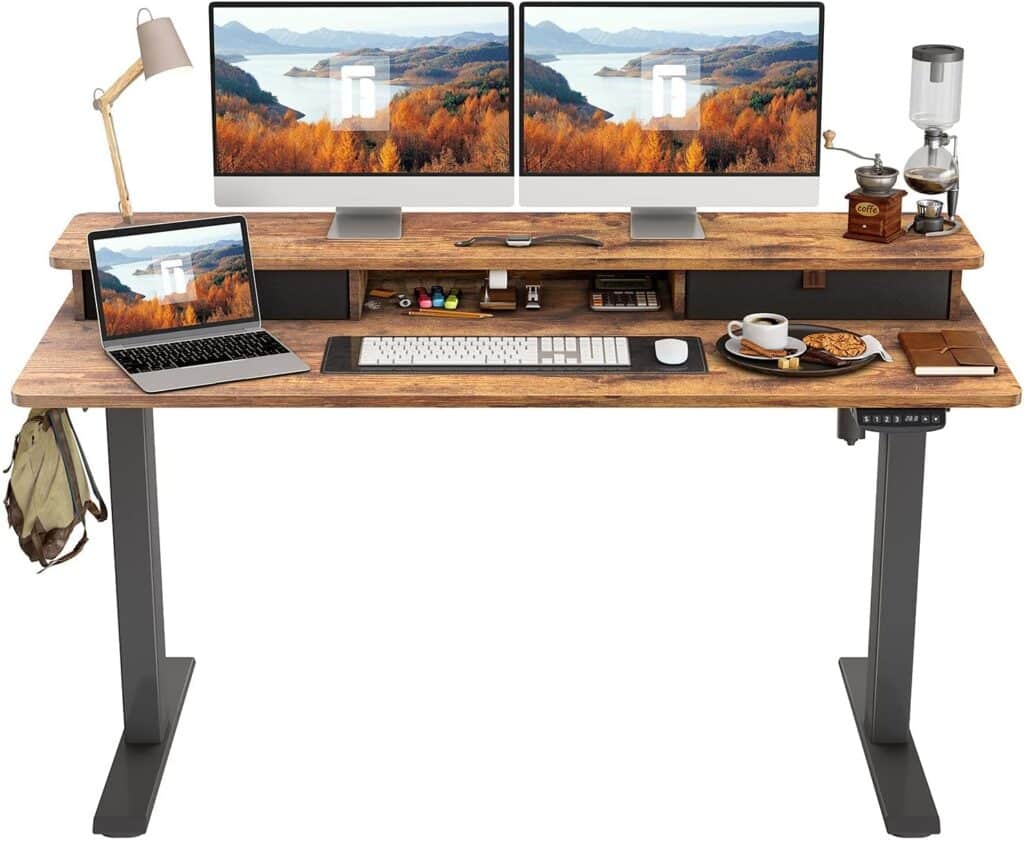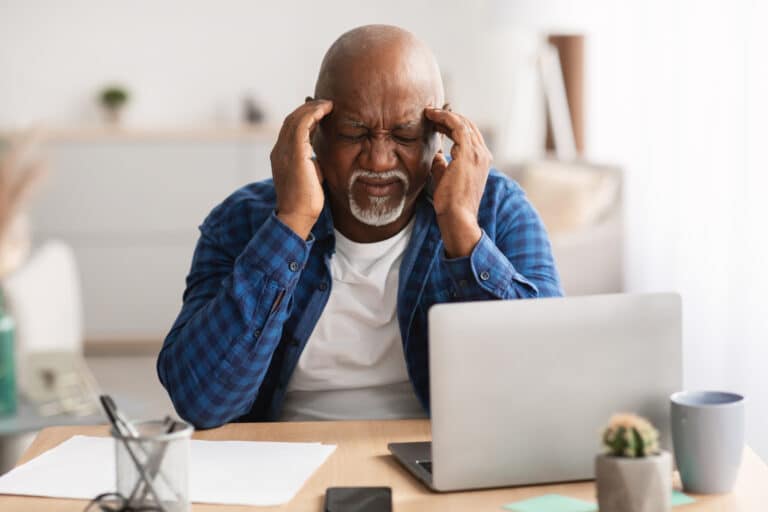Stress from reading the news online isn’t the only downside to computer use: our increased reliance on technology may also be harming our posture and our bodies.
Sitting with your head drooping while looking at your phone or tablet causes stress, leading to unnecessary neck and shoulder pain.
Fortunately, you can relieve pain with commonsense activity modifications and exercises. In this article, we’ll explore tech neck: its causes, effects, and solutions through simple exercises to avoid pain and discomfort.
What is Tech Neck?
Tech neck is the nickname for common problems caused by spending more time sitting and looking down at phones, computers, or other devices.
The tech neck (or text neck) phenomenon is recent, having emerged mainly in the 21st century. Prolonged time in this position, with the head hanging forward and a rounded upper back, can cause neck pain and degeneration of your spine.
The chronic stress and strain caused by this slouched position can lead to premature aging of tissues and various musculoskeletal problems. The most commonly reported areas of pain from tech neck are the upper back, neck, and shoulders. 1,2
Causes and Effects of Tech Neck

While tech neck is an increasingly prevalent problem among people of all ages, it can have particularly detrimental effects on older people who might already struggle with neck pain or postural issues. Here are some of the primary causes of this condition and the potential effects it can have on your daily life.
Causes
Spending most of our time sitting and a general lack of movement can worsen the symptoms of tech neck and other health conditions. Still, the root cause is poor posture from looking at screens.1
Your neck holds only ten to twelve pounds with a normal upright posture. With each degree that your head drifts forward, the weight demand on your neck increases exponentially, and strain and injury become more likely.
Effects

As you can see in this illustration, each degree of head tilt forward increases the pressure from gravity on the sensitive tissue of your neck and upper back.
While being in these positions for a short period can be tolerable, long periods of forward head tilt can result in chronic pain and dysfunction in the neck that can become severe over time.
Problems directly associated with tech neck include strained or weak neck muscles, poor neck posture, herniated discs, and nerve symptoms like numbness, tingling, and pain.1,3
Secondary effects of tech neck include weak back and abdominal muscles. Forward head and rounded shoulders posture causes the muscles between your shoulder blades to stretch and weaken. Standing with a hunched posture also causes a lack of abdominal muscle engagement, so the muscles in your midsection also tend to get weak.
Finally, when the deep muscles in the front of your neck weaken, the muscles in the back get tight. As a response, your chest muscles can become tight, and muscles opposite of that on your back become weak.
This tight-weak muscle relationship is called upper cross syndrome and can be a side effect of tech neck.3
These effects can compound across our lifetime, making posture correction necessary for older people and younger generations to prevent unnecessary pain as they age.4
How to Prevent Tech Neck

The best treatment is prevention. Practice good sitting posture if you are on your computer or phone for long periods. Find ways to stand rather than only sit when possible.
Frequently changing positions can also be beneficial. Find small breaks to stretch, walk around, or change your position during your day.2
At your desk, the angle of your keyboard, the height of your desk, your position in your chair, and the placement of your monitor all influence your posture. Here are some general points to consider when setting up your computer desk.
- Sit back in your chair with your back fully supported, your feet flat on the floor, and your knees below your hips.
- Lower the armrests of your chair or remove them altogether, keep your keyboard at elbow level, and ensure your shoulders are relaxed.
- Sit at least an arm’s length away from your screen.
- Line your eye level up with the top third of the monitor, and ensure the screen is centered to your body.
- Use a headset or speakerphone when taking phone calls to avoid bending your neck to the phone.
- When reading something on your cell phone screen, use a phone stand or keep the phone at eye level to avoid continuously looking down.
Finally, consider docking your laptop to a higher, larger screen while working. Larger screens are easier to see sizes, resulting in less straining and bending over your device.2,5
Get a Standing Desk
Actually, it’s more of a super-adjustable desk. We like the Fezibo Adjustable Electric Standing Desk for its versatility. It can be used in multiple positions and adjusted exactly to the right height. It also is electric, so no cranking or pinched fingers. Adjust it at the touch of a button!
Tech Neck Exercises
Physical therapy exercises for tech neck include strengthening and stretching to target areas around your back, neck, and shoulders.
These targeted strength exercises can be repeated for 10-12 repetitions, and be sure to hold the accompanying stretches for 20-30 seconds for three repetitions for the best effect.1,3
First, one of the most important exercises you can do to counter the effects of tech neck: Cervical chin tucks help to counter the areas of tension deep in the back of the neck that can lead to pain. Here’s how to do a chin tuck.


Chin Tucks
Sit or stand with your feet flat and your shoulders relaxed.
While looking down at the floor, move your head straight back as if you’re “making a double chin.” Note: Be careful not to simply tilt your head forward (chin to chest).
Hold each tuck for 5-7 seconds.
Cat-to-Cow
This is a similar movement, expressing the motion of the neck with the rest of your spine:
- Get on all fours with a neutral spine and perform a chin tuck (like the last exercise)
- With a big inhale, tilt your head back to look up at the ceiling while arching your back.
- As you exhale, round your back and actively tuck your chin.
- Repeat these movements, flowing back and forth from one to the other about 15-20 times.
Side-Lying Lateral Neck Flexion
To do the side-lying lateral neck flexion exercise:
- Lie on your side, propped up on your right elbow and hip.
- Looking straight ahead, tilt your head toward the ceiling.
- Repeat 8-12 times, then repeat on the other elbow.
Standing Rows
This exercise can be done with exercise tubing. Here’s how to do it:
- Standing straight with both arms out straight in front of you, gripping one handle in each hand
- Gently pull both arms to a bent position around ninety degrees. Be sure to avoid shrugging your shoulders at any point.
- As elbows bend, imagine you are trying to squeeze and hold a pencil between your shoulder blades at the center of your back.
Side Bending Neck Stretch
Here’s how to do the side-bending neck stretch:
- Sit up straight with your feet flat.
- Anchor your right arm by holding onto the side of the chair or sitting on your hand.
- Looking straight ahead, move your left ear to your left shoulder. You can use your left hand to deepen the stretch gently.
- Repeat on the other side.
Side-to-Side Rotation
To do the side-to-side rotation exercise:
- Sit up straight with feet flat.
- Without moving your shoulders, rotate your head to the right as if you’re trying to look behind you.
- Repeat to the left. Do 6-8 repetitions on each side.
Doorway Stretch
This is one of our favorite upper-body stretches. In the above video, Liz is stretching in a corner, but you can also use the sides of a door jamb.
- Standing in an open doorway (or corner as shown above), raise both arms to the side, keeping your elbows at 90 degrees, with palms facing forward.
- Place your hands and forearms on each side of the doorframe and slowly step forward with one foot to feel the stretch in your chest and shoulders.
- After holding for 20-30 seconds, step back and release.
Thoracic Spine Rotation
To do the thoracic spine rotation:
- Lie on your side with your knees bent at a 90-degree angle and your arms straight out in front of you with palms together.
- Without moving your lower half, the top arm up and behind you, allowing your chest to open toward the ceiling.
- You should feel a stretch in your mid-back. Hold for 30 seconds, then repeat on the opposite side.
In addition to stretching and strengthening, trigger point massage for tight and overworked muscles can also be beneficial. Massage can help to relieve pain, increase flexibility and improve muscle movement in tight tissues.
FAQs
What is Tech Neck and its Symptoms?
Tech neck, also known as text neck, is a condition arising from prolonged screen usage, leading to neck pain, stiffness, and spinal issues. Symptoms include discomfort in the upper back, neck, and shoulders, often accompanied by a forward head posture.
How Can I Prevent Tech Neck?
Preventing tech neck involves maintaining good posture while using devices, setting up an ergonomic workspace, taking frequent breaks to change positions, and incorporating specific exercises and stretches into your daily routine to strengthen and relax the neck and shoulder muscles.
What Are the Best Exercises for Tech Neck Relief?
Effective exercises for alleviating tech neck include cervical chin tucks, cat-to-cow stretches, thoracic spine rotations, side-to-side neck rotations, and doorway stretches. These exercises aim to strengthen the neck and shoulder muscles and improve flexibility.
How Does Screen Time Impact Neck Pain?
Increased screen time often leads to a forward head posture, straining the neck muscles and increasing the pressure on the spine. This can exacerbate neck pain and contribute to the development of tech neck.
Can Standing Desks Help Prevent Tech Neck?
Yes, standing desks can help prevent tech neck by promoting a more dynamic working posture, encouraging movement, and allowing for an ergonomic setup that aligns the monitor at eye level to reduce the need for bending or tilting the head forward.
What is the Relationship Between Tech Neck and Upper Cross Syndrome?
Tech neck can lead to upper cross syndrome, a condition characterized by tightness in the upper chest and weak muscles in the upper back and neck. This results from prolonged poor posture, contributing to imbalance and strain in the neck and shoulder region.
Summary
While technology will continue to become more ingrained in our lives, we have the tools to prevent the postural problems accompanying it.
The tips above can help reverse or prevent the pain and spinal degeneration that tech neck can cause. The most important thing we can do is to pay attention to cues to keep our posture upright and to pass the message along to our children and grandchildren to prevent pain for future generations.
Key Takeaways
- Tech neck, caused by prolonged screen use, can lead to neck pain and spine issues.
- Common symptoms include upper back, neck, and shoulder pain.
- Poor posture from screen viewing increases neck strain, contributing to tech neck.
- Older individuals may experience more severe effects, but all ages are at risk.
- Prevention includes good sitting posture, frequent position changes, and proper desk setup.
- Exercises like chin tucks, cat-to-cow stretches, and thoracic spine rotations can alleviate symptoms.
- Implementing a standing desk and ergonomic adjustments can also help prevent tech neck.
- Consistent exercise and proper posture are key to managing and preventing tech neck.
References
- Landis, A., & Peers, J. (n.d.). The Causes and Implications of Tech Neck. Retrieved from https://mescforyou.ksc.nasa.gov/Content/RehabWorks/Tech%20Neck%20Final.pdf
- Kim, H. J., DH, & Kim, J. S. (2015). The relationship between smartphone use and subjective musculoskeletal symptoms and university students. Journal of physical therapy science, 27(3), 575–579. https://doi.org/10.1589/jpts.27.575
- Miller, K. (n.d.). Correcting Upper Crossed Syndrome – NASM. NASM Blog. Retrieved from https://blog.nasm.org/correcting-upper-crossed-syndrome







